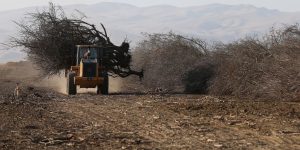By: John Miller

Denver International Airport on March 25, 2020 at 7:32am. Usually one of the busiest times in one of the busiest airports in the world.
I often write about the relationship between the almond industry and the beekeeping industry. These two groups are bound together. Beekeepers rely on hard-earned income from pollination services and almond growers rely on honey bees setting the almond blossom. This relationship between honey bees and almond trees is literally, millions of years old.
The almond industry is near the bottom of a cycle. 2023 almond prices paid to growers is in many cases, below costs of production. The roots of the situation are found in the 2022 Almond Almanac, a publication of the Almond Board of California. A copy can be downloaded at www.almonds.com. Go to the Tools and Resources tab, then scroll down to the Almond Almanac.
One chart in particular (print version on page 33) illustrates why now, in 2023 the almond industry struggles.
In the 2014/2015 crop, almond crop value hit $7,944 per bearing acre. That same year, the amount of the prior year crop carry in, as a percentage of the prior year shipments was 18%, a very manageable amount of carry in. In 2022, the carry in was 32%, almost 700 million pounds.
The carry in, coupled with the prior three years production of 3.3 to 3.5 billion-pound crops is a huge amount of crop to move.
Why are these crops so enormous? The invisible hand motivates farmers to grow more or grow less, depending on the opportunity to profit. Legislators and governors enact or do not enact taxes, limitations, build water-storage, or do not; expands and encourages or discourages improved highways and ports. Resources, always in competition for the supposed highest, best use are consumed. Weather patterns annually bless and curse different regions across the globe. In 2014, an almond grower saw farm price per pound for almonds above $4.00 a pound. Demand for almond ground expanded. Growers expanded acreage in areas with lots of good almond dirt, but not a lot of good almond water.
Enter three years of global chaos beginning in 2020; and the first of three – three billion-pound almond crops. A pandemic paralyzed global commerce. Export ports, especially in California utterly failed freight handling. A needless war in Ukraine heightened tensions. Ill-timed tariffs harmed global trade. Inflation reduced discretionary spending, globally. Buying almonds is discretionary. A hungry human, faced with buying peanut paste for .25/lb. and almond butter for $4.00/lb. will choose the former.
Nine years later, those trees planted in 2014 are now nearing full production. Ten years ago, growers made poor planting choices. For the first time in probably 20 years, the 2022 almond-bearing acreage went down. Bearing almond acreage will decline again in 2023. Prices for almonds will remain soft. Growers who perhaps got too far out over the tips of their skis are having awkward conversations with bankers and accountants.
This too shall pass.
 During the Almond Board Research Conference held annually in early December, speakers pointed out that the almond industry is resilient. 2022 marked the 50th anniversary of the ABC Research Conference. Speakers acknowledged the tough times. It is worth noting a few things: Global wealth continues to grow. Global human health has never been better. Some predict that within five years, five billion humans will be middle class consumers. Middle class consumers want to purchase aspirational foods, nutritious food. Almonds, globally, are aspirational. The almond industry will recover. Demand will recover in an industry that exports nearly 70% of its production.
During the Almond Board Research Conference held annually in early December, speakers pointed out that the almond industry is resilient. 2022 marked the 50th anniversary of the ABC Research Conference. Speakers acknowledged the tough times. It is worth noting a few things: Global wealth continues to grow. Global human health has never been better. Some predict that within five years, five billion humans will be middle class consumers. Middle class consumers want to purchase aspirational foods, nutritious food. Almonds, globally, are aspirational. The almond industry will recover. Demand will recover in an industry that exports nearly 70% of its production.
California is openly hostile to Ag. growers navigating how to thrive. Regulatory compliance now accounts for one of the top three costs in s grower’s business (the other two tall poppies are water costs and pollination fees). Growers will focus on better planting choices where water is more abundant: Sacramento Valley – not so much San Joaquin Valley. Pollination costs per acre may become more efficient and responsive to tree variety, density and terrain. Stocking rate recommendations should be science driven, not hunch driven. This is not news. Labor inputs will get a hard look. Whether planting pit-fruits, wheat, vines or keeping bees or cattle – all of Ag is engaged in a cost per unit, cost per acre and cost per hive analysis.
At least we should be.
During the ABC Conference, I was chatting with Josette Lewis, Chief Scientific Officer at ABC.
I’m fond of asking, “Where will we be in five years?” I asked Josette that very question. Her reply inspired me: “John, where do you think beekeeping will be in five years?”
I don’t know. I’ll write about that a little bit in 2023.
Here is a simple one: When the first genetically modified honey bee is engineered – What will be the reception?






